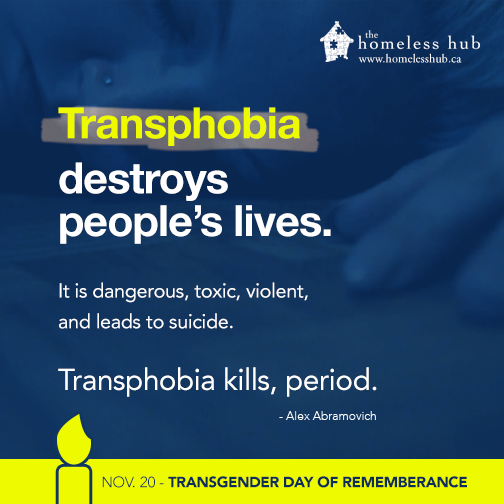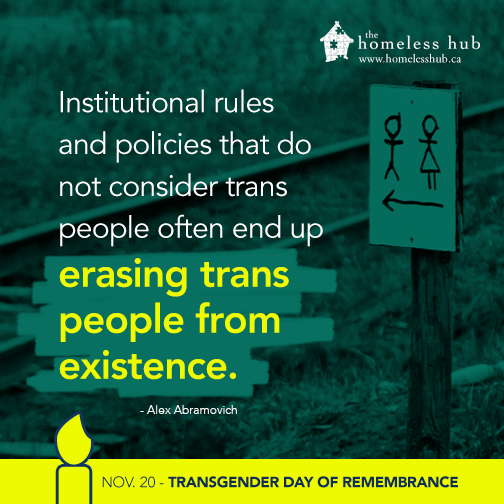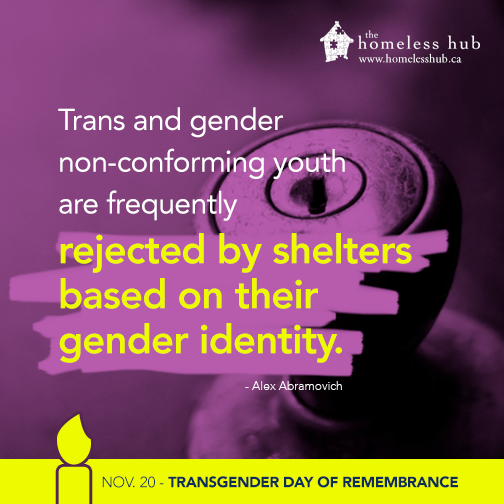Transgender Day of Remembrance (TDOR) held annually on November 20, is a day that is meant to memorialize transgender people who were killed or have died due to anti-transgender hatred and violence. It also raises public awareness of the violent reality that so many trans and gender non-conforming people face on a daily basis.
Every year, new names are added to the memorial list of trans people who have been killed due to transphobia. This year, on November 20, 2014 at 3pm, the City of Toronto will recognize TDOR for the first time by raising the trans flag at Toronto City Hall.
 Transphobia destroys people’s lives.
Transphobia destroys people’s lives.
It is dangerous, toxic, violent, and leads to suicide.
Transphobia kills, period.
Discrimination and violence against transgender individuals is rampant.
Trans people face disproportionately high rates of victimization, unemployment, health inequities, and suicidality. Trans people of colour, especially trans women of colour face the highest rates of violence and discrimination.
The Trans PULSE project, a large Canadian study that investigated health and trans people in Ontario, found that 77% of trans people had seriously considered suicide, and that 45% had attempted suicide. Trans youth were found to be at the greatest risk of suicidality. The high rates of suicide are extremely alarming, especially during the early stages of gender transition, which is when trans people are at greatest risk of suicide. The early stages of transition are also when young people are often kicked out of the house or forced to leave home.
Lesbian, gay, bisexual, transsexual, transgender, queer, questioning, and 2-Spirit (LGBTQ2S) youth are overrepresented in the homeless youth population: 25-40% of homeless youth identify as LGBTQ2S. Although there are disproportionately high rates of LGBTQ2S youth experiencing homelessness, there is minimal support available, and support services and shelters often further marginalize this population of young people.
Trans and gender non-conforming youth are frequently rejected by shelters based on their gender identity and are regularly not permitted to access the shelter that matches the gender with which they identify because shelters frequently do not feel equipped to support trans youth. This forces trans youth to stay in a shelter that is not consistent with their gender identity, or to avoid the shelter system altogether.
Regardless of shelter standards and shelter policies, frontline workers struggle most with issues regarding access to services and support for trans people, and shelter staff tend to receive minimal training regarding trans-related issues, needs, and terminology. Staff often do not have an understanding of the importance of asking youth what pronoun and name they prefer, or that trans people can also identify as heterosexual and do not always fit under the umbrella term “queer”.
There is a type of normalization of trans oppression that occurs in the shelter system. Even though major emphasis is placed on access and the ability to access shelters with as few barriers as possible, regardless of people’s gender and sexual identities, it has somehow come to be accepted that not all shelters can accommodate trans and gender non-conforming individuals.
 Shelters are often segregated by female and male floors, which have female and male bathrooms and showers. The floor that a person will be placed on has more to do with the staff’s perception of a person’s sex and less to do with how an individual actually identifies, which is highly problematic because not all individuals’ gender identity is congruent with the sex assigned to them at birth. For example, if someone presents as more gender ambiguous, then whatever the staff member perceives their sex to be, is what floor they will be placed on. This increases the risk for gender discrimination and gender violence to occur within shelters. It also creates significant barriers to access for genderqueer and gender non-conforming individuals, and individuals who are in the early stages of their transition.
Shelters are often segregated by female and male floors, which have female and male bathrooms and showers. The floor that a person will be placed on has more to do with the staff’s perception of a person’s sex and less to do with how an individual actually identifies, which is highly problematic because not all individuals’ gender identity is congruent with the sex assigned to them at birth. For example, if someone presents as more gender ambiguous, then whatever the staff member perceives their sex to be, is what floor they will be placed on. This increases the risk for gender discrimination and gender violence to occur within shelters. It also creates significant barriers to access for genderqueer and gender non-conforming individuals, and individuals who are in the early stages of their transition.
The need for transgender youth to have access to health care professionals who have a comprehensive understanding of trans-related issues and transition-related health care is crucial. The health care needs of trans youth differ from those of lesbian, gay, and bisexual youth, whether they are experiencing homelessness or not. For example, trans youth may need transition related health care, including access to hormones or surgery, or help getting ID and legal name change sorted out. The lack of specialized health care services for trans youth often results in youth turning to unmonitored street suppliers for transition-related treatment, which can have severe health complications (Quintana et al., 2010). The complexity of these needs intensifies when one is homeless and does not have money, a health card, or a support network.
Being a young person is scary, regardless of your sexual or gender identity. Being a young person who deviates from the norm is terrifying because our culture pathologizes almost every feeling and behaviour that human beings are capable of expressing. The extreme pathologization of gender makes it even more difficult for people to bring their full authentic selves to programs and support services, and to come out as transgender.
 Solutions to these issues include practice and policy changes, but first and foremost, people must be respected and treated in their self-identified gender. For example, if someone says that they identify as male, then address them with male pronouns. If someone says that they identify as female, then address them with female pronouns. If someone says that they identify as genderqueer and prefer gender-neutral pronouns, such as they, then address them using they.
Solutions to these issues include practice and policy changes, but first and foremost, people must be respected and treated in their self-identified gender. For example, if someone says that they identify as male, then address them with male pronouns. If someone says that they identify as female, then address them with female pronouns. If someone says that they identify as genderqueer and prefer gender-neutral pronouns, such as they, then address them using they.
Shelters and support services need to be equipped with gender-neutral washrooms. Single occupancy washrooms can be easily converted into a gender-neutral washroom by replacing the female and male silhouette signs with an all gender inclusive sign.
Taking the time to listen to trans youths’ perspectives and needs will help service providers create services that are safe, accessible, and supportive of trans and gender non-conforming youth.
On this day, the Transgender Day of Remembrance, take the time to honour the lives of those who have been killed as a result of anti-trans violence and hatred. Do your part to help end transphobia, not only on November 20, but every day.
Transphobia is an everyday reality for too many individuals.
Transphobia destroys people’s lives.
It is dangerous, toxic, violent, and leads to suicide.
Transphobia kills, period.
Photos credits: Flickr/cuppojoe_trips, hollylay, jkunz

